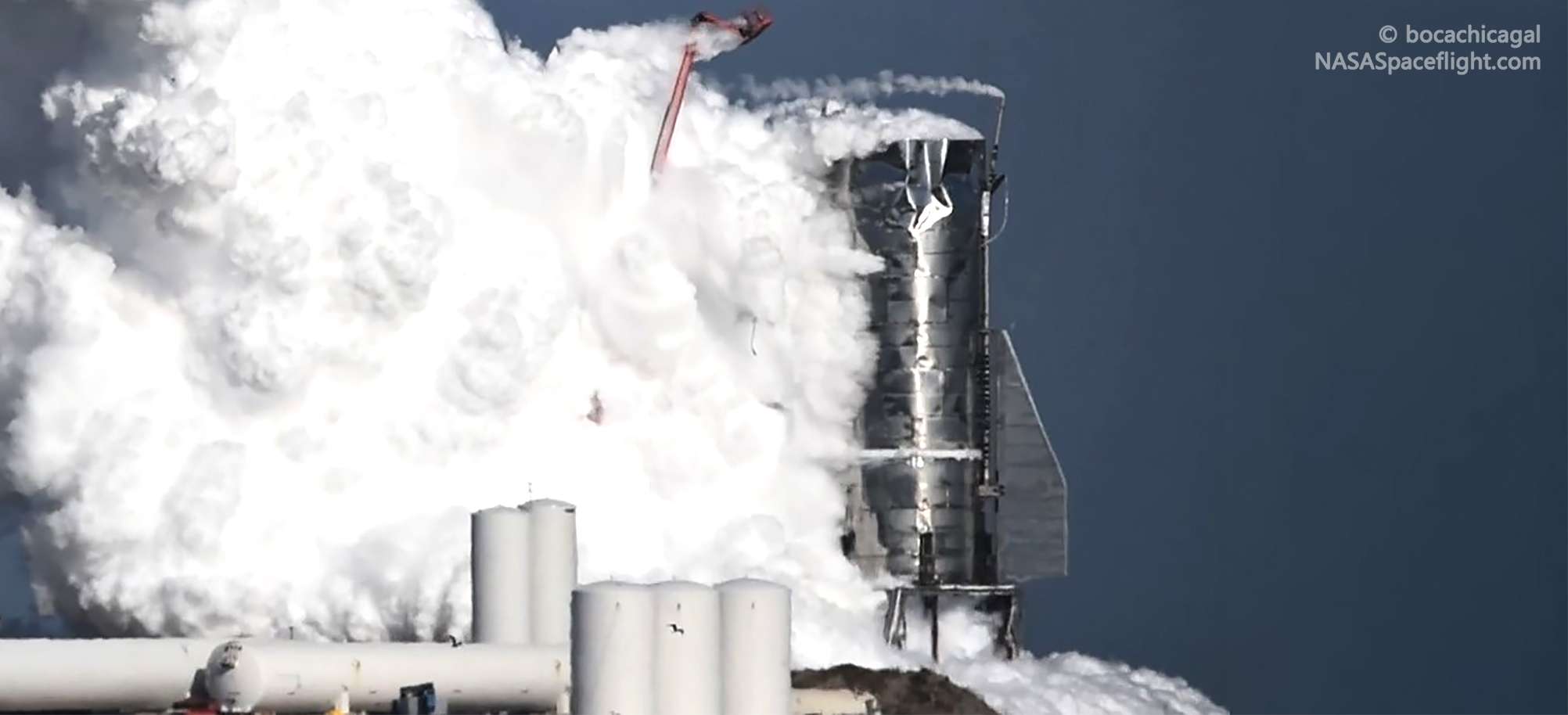
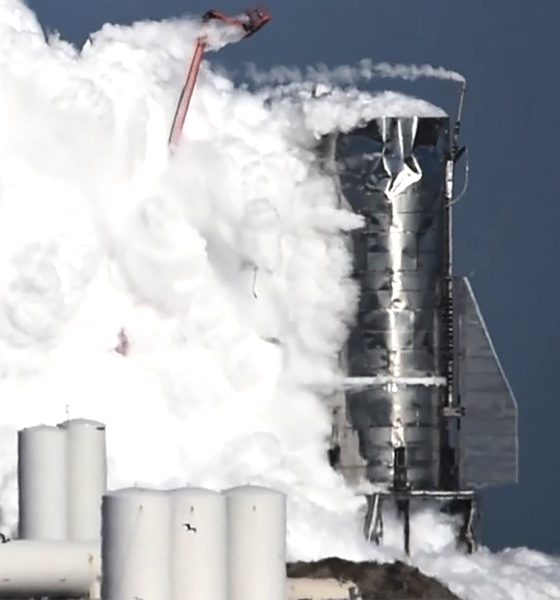
News
SpaceX Starship blew its top during rocket fueling test (updated)
Update: SpaceX has released an official statement indicating that Starship Mk1’s November 20th failure came after a decision to intentionally pressurize the rocket prototype to its limits. This likely means that the test was to max flight pressures and not an intentional burst test, so Starship’s dome failure is still a significant concern and was definitely not planned.
More importantly, SpaceX says that it had already decided to retire Starship Mk1 before any kind of flight testing, treating the vehicle as a pathfinder. Instead, SpaceX will build and use Starship Mk3 – the next Boca Chica prototype – for Starship’s first attempted skydiver-style landing and 20 km (12 mi) flight test.
SpaceX statement on the above test and incident: pic.twitter.com/r1ReRYhUhz— Michael Sheetz (@thesheetztweetz) November 21, 2019
SpaceX’s first full-scale Starship prototype has suffered a significant failure during testing, destroying or severely damaging large sections of the rocket. However, SpaceX CEO Elon Musk has already commented on the anomaly and is not all that concerned.
On November 20th, SpaceX – having canceled a planned road closure the day prior – unexpectedly requested a last-second road closure and entered into a much more serious round of testing with Starship Mk1, the rocket’s first full-scale prototype. This followed testing on November 18th that concluded with Starship Mk1’s very first ‘breath’ – some venting activity near the end of a tank proof test. SpaceX technicians spent the next 36 or so hours inspecting and working on Mk1, presumably looking for and patching minor leaks along its tank section.
The November 20th testing progressed far faster than the previous round of tests and Starship Mk1 was quickly venting again. Soon after that, frost began to appear on the exterior of its steel liquid oxygen and methane tanks, a telltale sign that some form of cryogenic testing was ongoing. Based on a distinct lack of activity at the nearby flare stack, SpaceX was using liquid oxygen (LOX) or liquid nitrogen (LN2) to verify that Starship performs as expected when filled with supercool propellant.
After initial venting and visible frost formation, SpaceX appeared to push forward, rapidly loading Starship Mk1 with LOX or LN2. This progress was easily visible thanks to the fact that the mass and pressure of all that cryogenic liquid made quick work of the slight imperfections on the exterior of Starship’s steel hull, turning the vehicle’s reflection from a speckled patchwork to an almost mirror-like finish. Roughly half an hour later, the otherwise peaceful scene was interrupted by the rapid failure of Starship Mk1’s upper LOX tank dome, instantly thrown several hundred feet into the air.
Seconds later, the crumpled upper half of Starship Mk1’s tank section appeared out of the clouds created and began hemorrhaging a huge volume of liquid oxygen, immediately boiling and vaporizing as it was exposed to the Earth’s comparatively white-hot atmosphere. Impressively, Starship appeared to remain functional after its top quite literally blew off, and the vehicle rapidly detanked and appeared to safe itself. Some ten minutes after the overpressure event, the freed liquid oxygen had boiled to nothing and Starship appeared to be quiet.
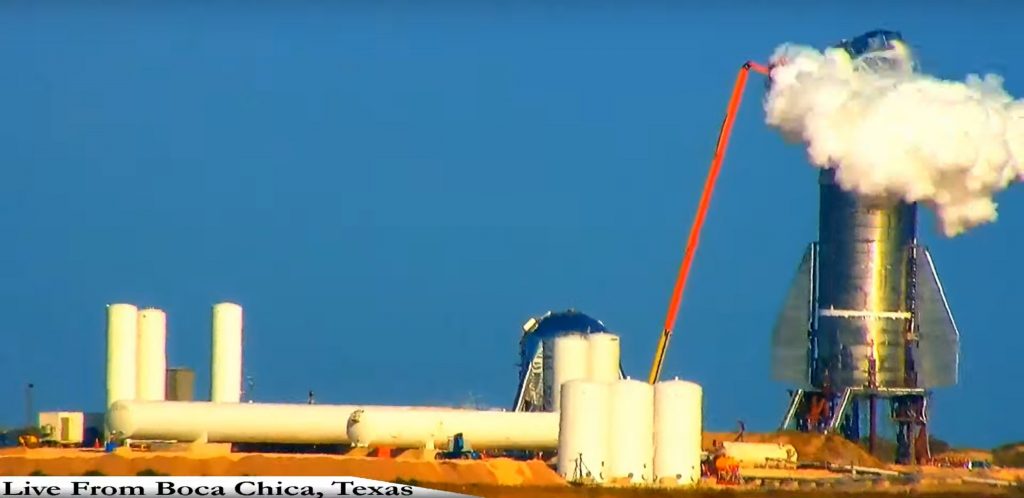
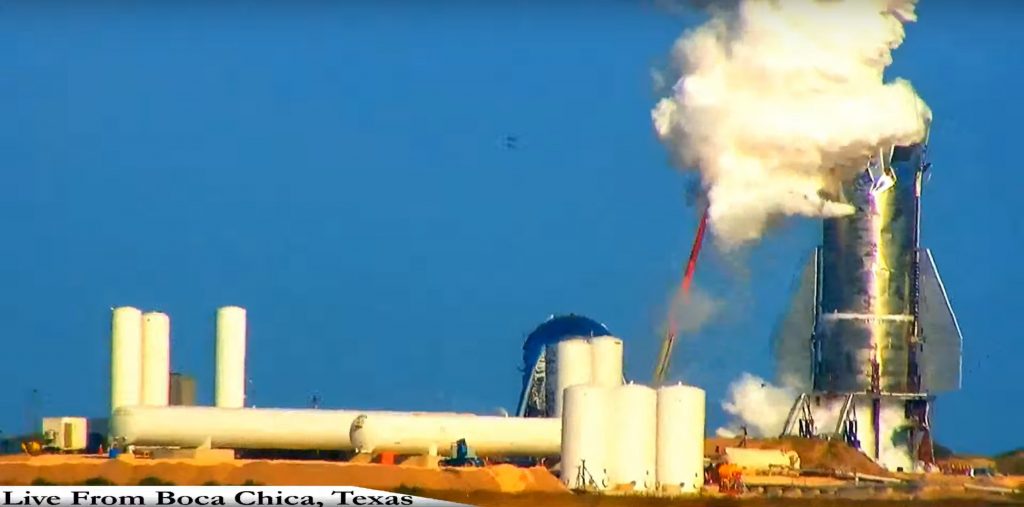
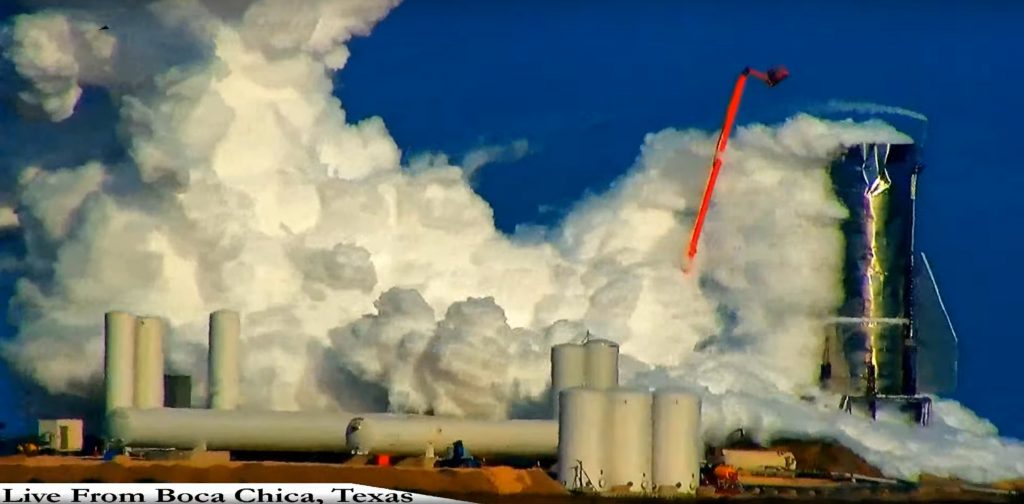
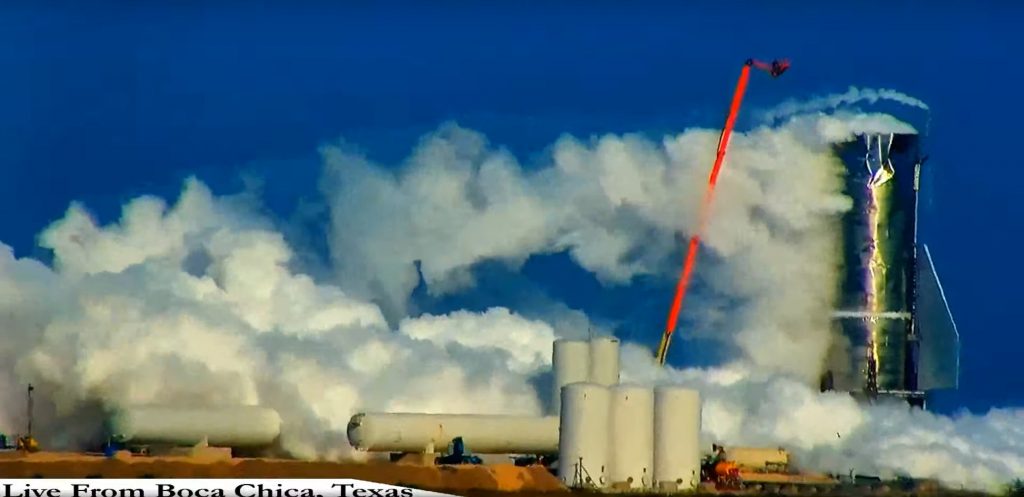
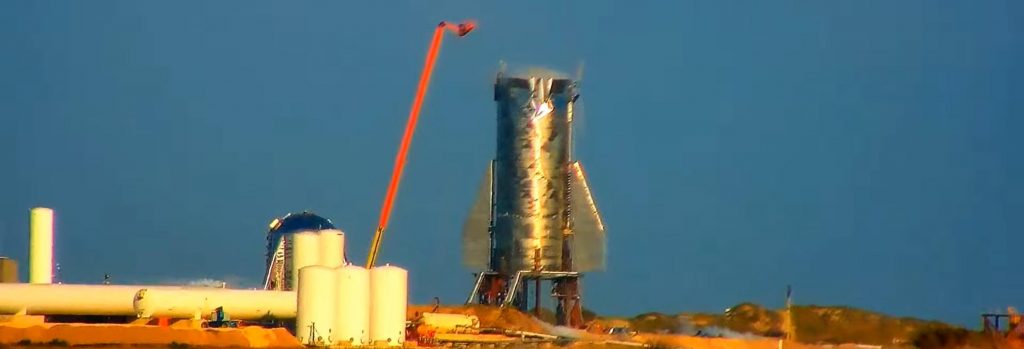
By all appearances, Starship Mk1 appeared to perform extremely well as an integrated system up to the point that its upper tank dome failed. The first frame from LabPadre’s stream with anything visibly amiss explicitly implicates the weld connecting the LOX dome to the cylindrical body of Starship’s LOX tank, point to a bad weld joint as the likeliest source of the failure. Although that hardware failure is unfortunate, Mk1’s loss will hopefully guide improvements in Starship’s design and manufacturing procedures.
Moving forward
Minutes after the anomaly was broadcast on several unofficial livestreams of SpaceX’s Boca Chica facilities, SpaceX CEO Elon Musk acknowledged Starship Mk1’s failure in a tweet, telegraphing a general lack of worry. Of note, Musk indicated that Mk1 was valuable mainly as a manufacturing pathfinder, entirely believable but also partially contradicting his September 2019 presentation, in which he pretty clearly stated that Mk1 would soon be launched to ~20 km to demonstrate Starship’s exotic new skydiver landing strategy.
Musk says that instead of repairing Starship Mk1, SpaceX’s Boca Chica team will move directly to Starship Mk3, a significantly more advanced design that has benefitted from the numerous lessons learned from building and flying Starhopper and fabricating Starship Mk1. The first Starship Mk3 ring appears to have already been prepared, but SpaceX’s South Texas focus has clearly been almost entirely on preparing Starship Mk1 for wet dress rehearsal, static fire, and flight tests. After today’s failure, it sounds like Mk1 will most likely be retired early and replaced as soon as possible by Mk3.
Above all else, the most important takeaway from today’s Starship Mk1 anomaly is that the vehicle was a very early prototype and SpaceX likely wants to have vehicle failures occur on the ground or in-flight. As long as no humans are at risk, pushing Starship to failure (or suffering unplanned failures like today’s) can only serve to benefit and improve the vehicle’s design, especially when the failed hardware can be recovered intact (ish) and carefully analyzed.
A step further, SpaceX is simultaneously building a second (and third) Starship prototype at its companion Cocoa, Florida facilities, and Starship Mk2 is nearly finished. Coincidentally, technicians installed its last tank dome – the same dome that failed on Mk1 – just days ago, and any insight that the Boca Chica team can gather from Mk1’s troubles will almost certainly be applied to Mk2, whether that means reinforcing its existing domes or fully replacing the upper dome with an improved design.
Check out Teslarati’s Marketplace! We offer Tesla accessories, including for the Tesla Cybertruck and Tesla Model 3.

Elon Musk
Tesla CEO Elon Musk teases insane capabilities of next major FSD update

Tesla CEO Elon Musk teased the insane capabilities of the next major Full Self-Driving update just hours after the company rolled out version 14.2 to owners.
Tesla Full Self-Driving v14.2 had some major improvements from the previous iteration of v14.1.x. We were on v14.1.7, the most advanced configuration of the v14.1 family, before Tesla transitioned us and others to v14.2.
However, Musk has said that the improvements coming in the next major update, which will be v14.3, will be where “the last big piece of the puzzle finally lands.”
14.3 is where the last big piece of the puzzle finally lands
— Elon Musk (@elonmusk) November 21, 2025
There were some major improvements with v14.2, most notably, Tesla seemed to narrow in on the triggers that caused issues with hesitation and brake stabbing in v14.1.x.
One of the most discussed issues with the past rollout was that of brake stabbing, where the vehicle would contemplate proceeding with a route as traffic was coming from other directions.
We experienced it most frequently at intersections, especially four-way stop signs.
Elon Musk hints at when Tesla can fix this FSD complaint with v14
In our review of it yesterday, it was evident that this issue had been resolved, at least to the extent that we had no issues with it in a 62-minute drive, which you can watch here.
Some owners also reported a more relaxed driver monitoring system, which is something Tesla said it was working on as it hopes to allow drivers to text during operation in the coming months. We did not test this, as laws in Pennsylvania prohibit the use of phones at any time due to the new Paul Miller’s Law, which took effect earlier this year.
However, the improvements indicate that Tesla is certainly headed toward a much more sentient FSD experience, so much so that Musk’s language seems to be more indicative of a more relaxed experience in terms of overall supervision from the driver, especially with v14.3.
Musk did not release or discuss a definitive timeline for the release of v14.3, especially as v14.2 just rolled out to Early Access Program (EAP) members yesterday. However, v14.1 rolled out to Tesla owners just a few weeks ago in late 2025. There is the potential that v14.3 could be part of the coming Holiday Update, or potentially in a release of its own before the New Year.
News
Tesla Full Self-Driving v14.2 – Full Review, the Good and the Bad

Tesla rolled out Full Self-Driving version 14.2 yesterday to members of the Early Access Program (EAP). Expectations were high, and Tesla surely delivered.
With the rollout of Tesla FSD v14.2, there were major benchmarks for improvement from the v14.1 suite, which spanned across seven improvements. Our final experience with v14.1 was with v14.1.7, and to be honest, things were good, but it felt like there were a handful of regressions from previous iterations.
While there were improvements in brake stabbing and hesitation, we did experience a few small interventions related to navigation and just overall performance. It was nothing major; there were no critical takeovers that required any major publicity, as they were more or less subjective things that I was not particularly comfortable with. Other drivers might have been more relaxed.
With v14.2 hitting our cars yesterday, there were a handful of things we truly noticed in terms of improvement, most notably the lack of brake stabbing and hesitation, a major complaint with v14.1.x.
However, in a 62-minute drive that was fully recorded, there were a lot of positives, and only one true complaint, which was something we haven’t had issues with in the past.
The Good
Lack of Brake Stabbing and Hesitation
Perhaps the most notable and publicized issue with v14.1.x was the presence of brake stabbing and hesitation. Arriving at intersections was particularly nerve-racking on the previous version simply because of this. At four-way stops, the car would not be assertive enough to take its turn, especially when other vehicles at the same intersection would inch forward or start to move.
This was a major problem.
However, there were no instances of this yesterday on our lengthy drive. It was much more assertive when arriving at these types of scenarios, but was also more patient when FSD knew it was not the car’s turn to proceed.
Can report on v14.2 today there were ZERO instances of break stabbing or hesitation at intersections today
It was a significant improvement from v14.1.x
— TESLARATI (@Teslarati) November 21, 2025
This improvement was the most noticeable throughout the drive, along with fixes in overall smoothness.
Speed Profiles Seem to Be More Reasonable
There were a handful of FSD v14 users who felt as if the loss of a Max Speed setting was a negative. However, these complaints will, in our opinion, begin to subside, especially as things have seemed to be refined quite nicely with v14.2.
Freeway driving is where this is especially noticeable. If it’s traveling too slow, just switch to a faster profile. If it’s too fast, switch to a slower profile. However, the speeds seem to be much more defined with each Speed Profile, which is something that I really find to be a huge advantage. Previously, you could tell the difference in speeds, but not in driving styles. At times, Standard felt a lot like Hurry. Now, you can clearly tell the difference between the two.
It seems as if Tesla made a goal that drivers should be able to tell which Speed Profile is active if it was not shown on the screen. With v14.1.x, this was not necessarily something that could be done. With v14.2, if someone tested me on which Speed Profile was being used, I’m fairly certain I could pick each one.
Better Overall Operation
I felt, at times, especially with v14.1.7, there were some jerky movements. Nothing that was super alarming, but there were times when things just felt a little more finicky than others.
v14.2 feels much smoother overall, with really great decision-making, lane changes that feel second nature, and a great speed of travel. It was a very comfortable ride.
The Bad
Parking
It feels as if there was a slight regression in parking quality, as both times v14.2 pulled into parking spots, I would have felt compelled to adjust manually if I were staying at my destinations. For the sake of testing, at my first destination, I arrived, allowed the car to park, and then left. At the tail-end of testing, I walked inside the store that FSD v14.2 drove me to, so I had to adjust the parking manually.
This was pretty disappointing. Apart from parking at Superchargers, which is always flawless, parking performance is something that needs some attention. The release notes for v14.2. state that parking spot selection and parking quality will improve with future versions.
Any issues with parking on your end? 14.1.7 didn’t have this trouble with parking pic.twitter.com/JPLRO2obUj
— TESLARATI (@Teslarati) November 21, 2025
However, this was truly my only complaint about v14.2.
You can check out our full 62-minute ride-along below:
Elon Musk
SpaceX issues statement on Starship V3 Booster 18 anomaly
The incident unfolded during gas-system pressure testing at the company’s Massey facility in Starbase, Texas.

SpaceX has issued an initial statement about Starship Booster 18’s anomaly early Friday. The incident unfolded during gas-system pressure testing at the company’s Massey facility in Starbase, Texas.
SpaceX’s initial comment
As per SpaceX in a post on its official account on social media platform X, Booster 18 was undergoing gas system pressure tests when the anomaly happened. Despite the nature of the incident, the company emphasized that no propellant was loaded, no engines were installed, and personnel were kept at a safe distance from the booster, resulting in zero injuries.
“Booster 18 suffered an anomaly during gas system pressure testing that we were conducting in advance of structural proof testing. No propellant was on the vehicle, and engines were not yet installed. The teams need time to investigate before we are confident of the cause. No one was injured as we maintain a safe distance for personnel during this type of testing. The site remains clear and we are working plans to safely reenter the site,” SpaceX wrote in its post on X.
Incident and aftermath
Livestream footage from LabPadre showed Booster 18’s lower half crumpling around the liquid oxygen tank area at approximately 4:04 a.m. CT. Subsequent images posted by on-site observers revealed extensive deformation across the booster’s lower structure. Needless to say, spaceflight observers have noted that Booster 18 would likely be a complete loss due to its anomaly.
Booster 18 had rolled out only a day earlier and was one of the first vehicles in the Starship V3 program. The V3 series incorporates structural reinforcements and reliability upgrades intended to prepare Starship for rapid-reuse testing and eventual tower-catch operations. Elon Musk has been optimistic about Starship V3, previously noting on X that the spacecraft might be able to complete initial missions to Mars.








